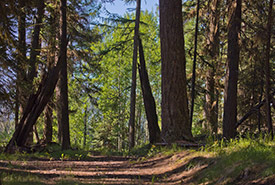Lehmann Springs Conservation Area

Lehmann Springs Conservation Area (Photo by J. Duane Sept)
With its towering trees and natural springs, Lehmann Springs Conservation Area is truly an ecological treasure. The forested 24-hectare site near Osoyoos supports some of the largest larch trees in British Columbia, some more than 600 years old and reaching up to 51 metres in height. Ponderosa pine, spruce and interior Douglas-fir trees also grow here, while the many snags provide habitat for insects, birds and mammals.
This forest is home to a variety of wildlife and at-risk species, including American badger (endangered), Williamson’s sapsucker (endangered), olive-sided flycatcher (threatened) and evening grosbeak (special concern).
This area gets its name from the Lehmann family, who donated this land for conservation, and from the abundance of natural springs within the forest. There are at least nine springs where water can be seen bubbling up from the ground. These springs, which support tiny freshwater shrimp, are the headwaters for Nine Mile Creek, which flows into Osoyoos Lake.
In 2015, the Lehmann Springs Conservation Area was part of a 26-property transfer from The Land Conservancy to the Nature Conservancy of Canada.
Williamson’s Sapsucker Habitat Enhancement Project
As larch forests in British Columbia are harvested for timber, converted for agriculture and cleared for settlement, habitat for Williamson's sapsuckers is disappearing and is not easily replaced. Today, this federally endangered migratory woodpecker breeds in pockets of habitat only in the Princeton-Merritt, Okanagan-Boundary and East Kootenay regions of BC. There are no other suitably old larch forests in the province for this bird to reproduce in.
NCC is working to ensure the existing critical habitat for Williamson’s sapsucker at Lehmann Springs remains intact and continues to support this species over the long term. This means that existing old-growth larch nesting trees and ant food sources for Williamson's sapsucker must be conserved, and that future nest trees are created and additional food sources are established and managed.
Between 2020 and 2023, NCC carried out several stewardship activities to help the larch forest remain high-quality habitat for Williamson’s sapsucker and other key wildlife. The action plan was developed in collaboration with the Canadian Wildlife Service and a Williamson's sapsucker expert. Some of the key activities included:
- Removing blowdown to reduce fire hazard.
- Thinning young Douglas-fir trees to reduce competition with existing western larch nesting trees.
- Planting western larch trees as a wind break and begin recruitment of future nest trees.
- Controlling invasive species to maintain biodiversity and health of this conservation area.
- Constructing coarse woody debris piles to create prey species habitat and denning opportunities for the endangered American badger.




